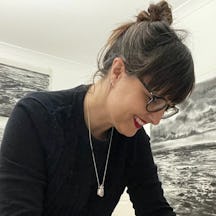For artist Liz Atkin, shame about skin picking has, over time, evolved into compassion and curiosity. Dance, photography and charcoal on paper have enabled Liz to understand, manage and creatively collaborate with anxiety and compulsion. Here she explains how an overwhelming urge to pick can be steered away from her skin and into her art.
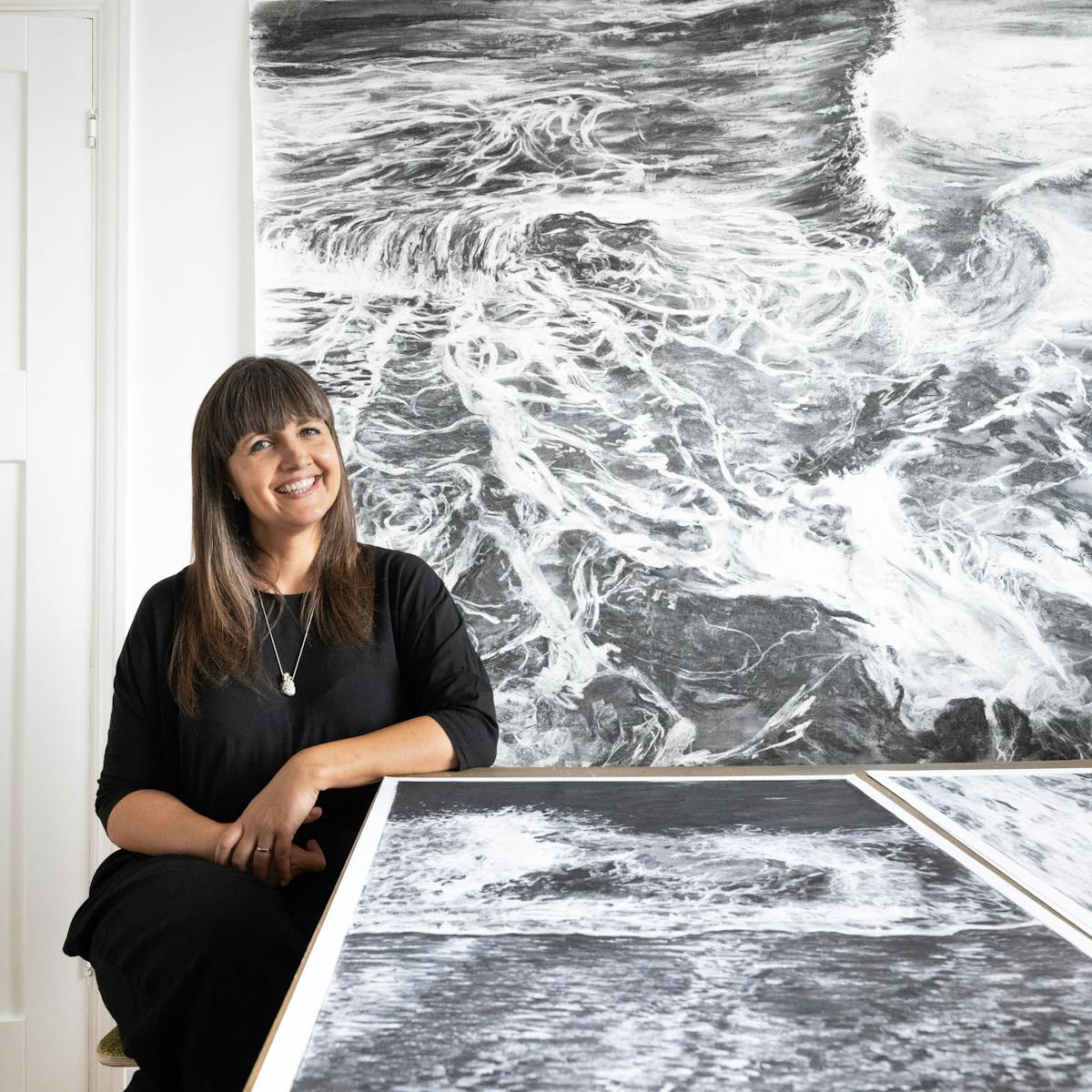
From early childhood I had an intense urge to pick. A growing tension would rise in my body, my hands scanning my skin for an irregularity, a texture, a spot or a dry patch to smooth out. Then tdg tdg tdg as my fingernail repetitively caught on the rough edge of a scab or blemish, hooking under it to pull it away. I was often unaware it was happening until I looked down and saw the familiar dot of blood. Instinctively I’d hide my hand from view and quickly suck the blood away.
Compulsive skin picking is my restless companion. For years I did everything I could to ignore it. So much pain and shame were entangled with this thing – I thought it was a bad habit that I should just be able to stop. It was decades before art and drawing shifted me into a new place of creative collaboration with the condition.
I had the courage to search online for it in my late 20s and found a name and diagnosis for this uncontrollable behaviour. Compulsive skin picking is also known as ‘dermatillomania’ and ‘excoriation disorder’. It’s classed within ‘Obsessive-Compulsive Disorder and Related Disorders’ in the Diagnostic and Statistical Manual of Mental Disorders (DSM-5), and is an impulse-control disorder in a family of conditions known as body-focused repetitive behaviours, or BFRBs.
Creative intervention
I started making artwork about my skin picking during an MA in Dance, a compassionate and curious journey. I began contemplating what my picking could show me. What if there was something creative in this compulsion?
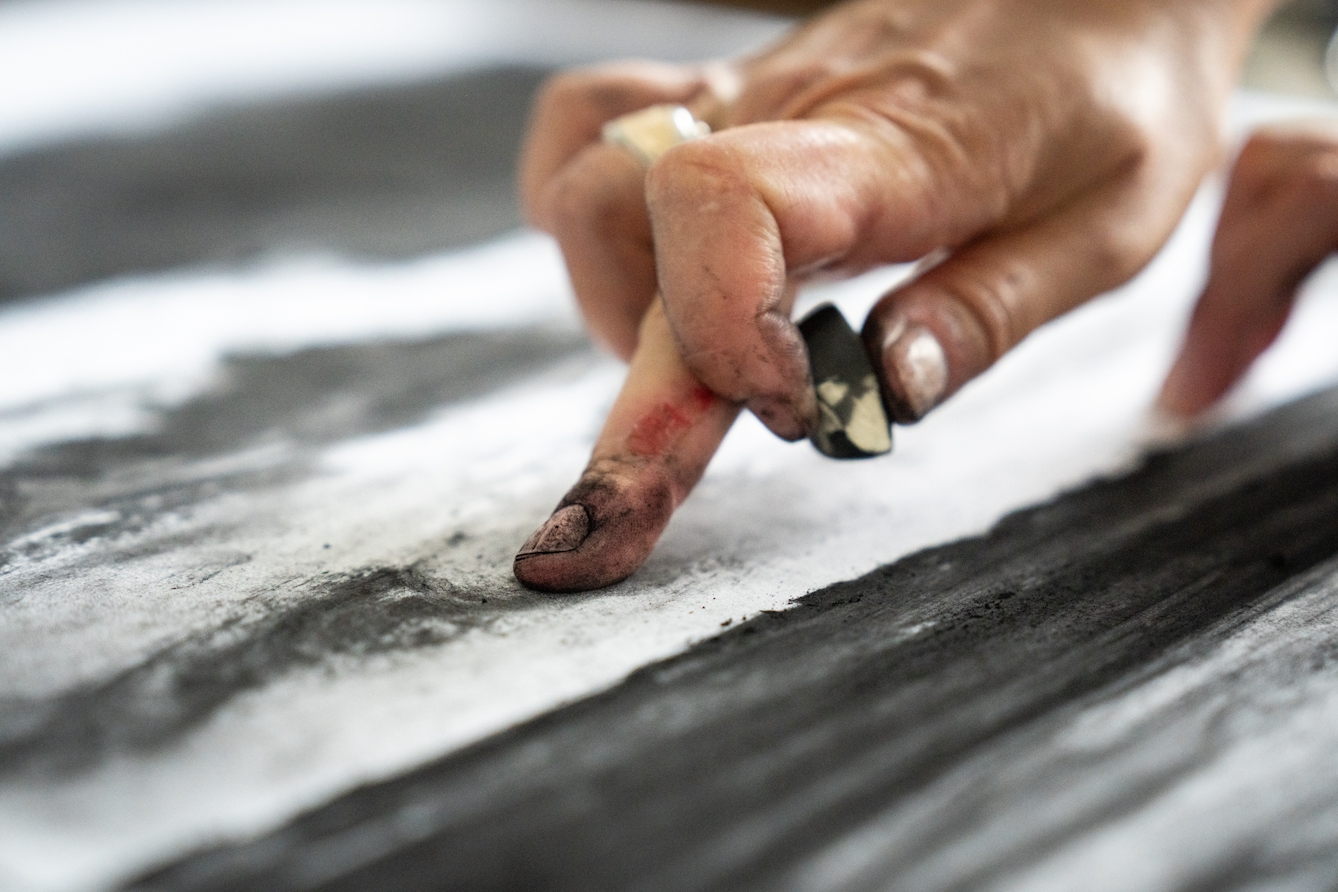
“A growing tension would rise in my body, my hands scanning my skin for an irregularity, a texture, a spot or a dry patch to smooth out.”
At first I made photographic self-portraits and created dances about the disorder as I began to identify the way it animated my movements and gestures. Slowly I began to realise that my fascination with texture is deeply interconnected with my skin picking. Cracked paint, rust, layered graffiti, decayed surfaces have always obsessed me – I would take thousands of photographs on my phone. These things continue to flow into my artwork.
By my mid-30s, an internal crisis was brewing and the skin picking had increased to unprecedented levels. Depression and anxiety meant I was on sick leave for a year, and my life stalled. Panic attacks started to dominate my journeys on public transport and my therapist suggested I needed something to occupy myself.
And then a friend gave me a box of compressed charcoal as a present and, on a whim, I decided to take it and a sketchbook with me when I travelled.
The first time I drew on the train, I was struck by the way I felt everything slow down into a focused state. I was able to complete the journey without a panic attack.
When my sketchbook ran out one day, I felt the urge to draw anyway, so I used a free newspaper as my canvas. Seeing that my fellow passengers were inquisitive, I started giving the drawings away. I called them ‘compulsive charcoal drawings’ and created them on almost every journey I made on public transport.
“Slowly I began to realise that my fascination with texture is deeply interconnected with my skin picking.”
Giving the drawings away was an act of kindness but also an opportunity to talk about mental health – specifically skin picking – with others. I was astonished to hear so many people identify with what I was saying. They told me about their own body-focused repetitive behaviour or about someone they knew who did it.
Drawing with charcoal became a creative and meditative intervention. It offered a soothing antidote to the sensory challenges of skin picking. My rhythm, touch and gaze shifted from the surface of my body to making marks on paper. Drawing in the evening – a triggering time for skin picking for me – was a game changer, regulating tension before going to bed.
Sea change
In 2019, a body of my artwork and an archive of my advocacy was acquired by Wellcome Collection. The invitation came at a particular point in time, just before Covid. Since then, my practice has continued to evolve. But the acquisition was undeniably validating for both me as an artist and for skin picking as a condition.
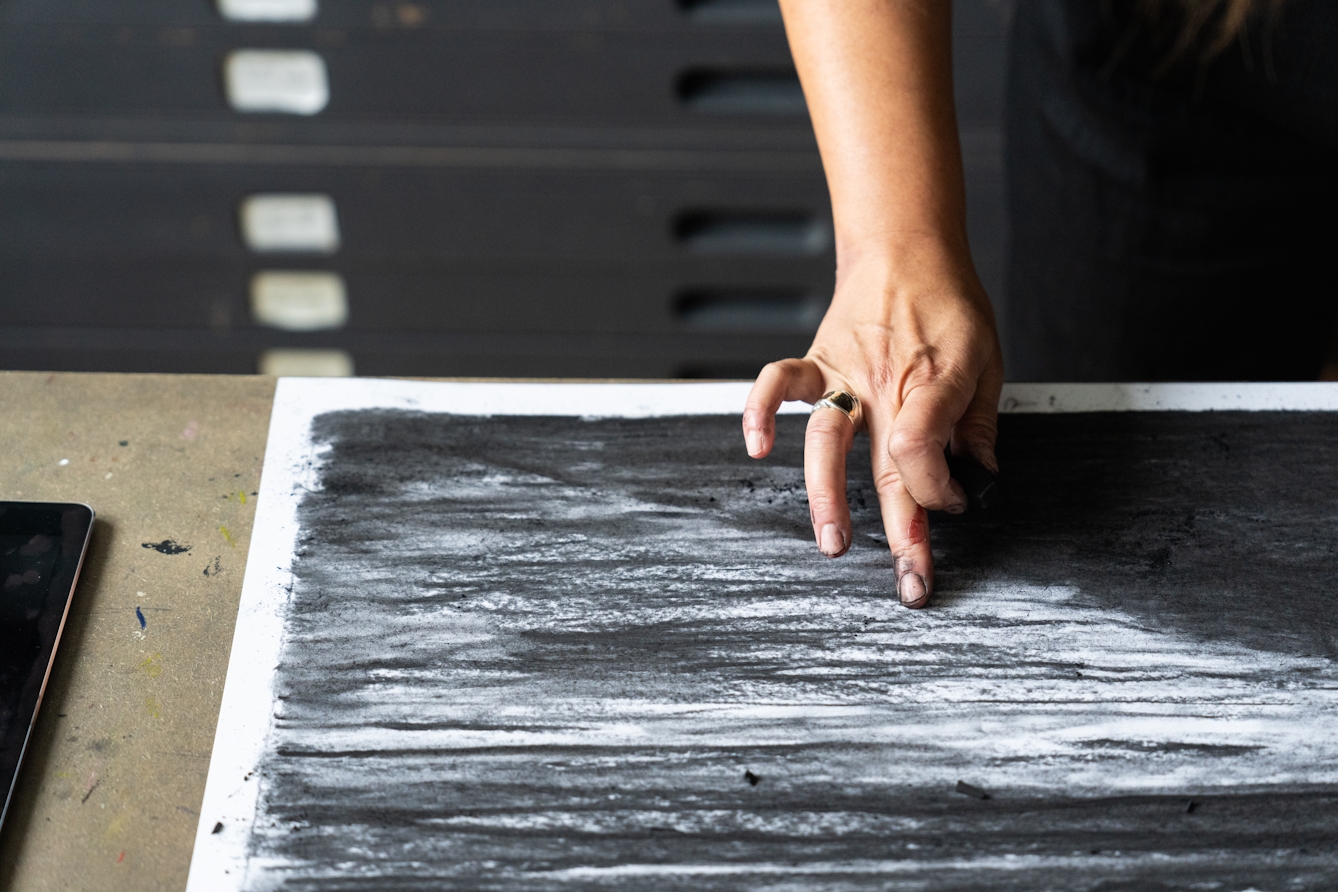
“My rhythm, touch and gaze shifted from the surface of my body to making marks on paper.”
Skin picking gets such limited press and is widely misunderstood, so I was honoured to contribute work to a collection committed to creative research, health and human experiences. It’s also somewhat overwhelming to think of it being held beyond my lifetime!
After the pandemic, I relocated to Whitstable on the Kent coast, where I have found a new affinity with the restlessness of the sea. It seems to mirror the relentless energy of skin picking when my emotions are out of kilter. I get great comfort from the movement of water, the patterns, the rhythms, repetitions and flow, the ever-changing light and mood.
I am drawn to the sea. In my studio, wide horizons appear in my drawings of all sizes. Shoreline, water-pattern complexity, dramatic skies and dense tones. I love to draw on paper pinned up on the studio wall that’s as large as I can reach, allowing for physicality and movement.
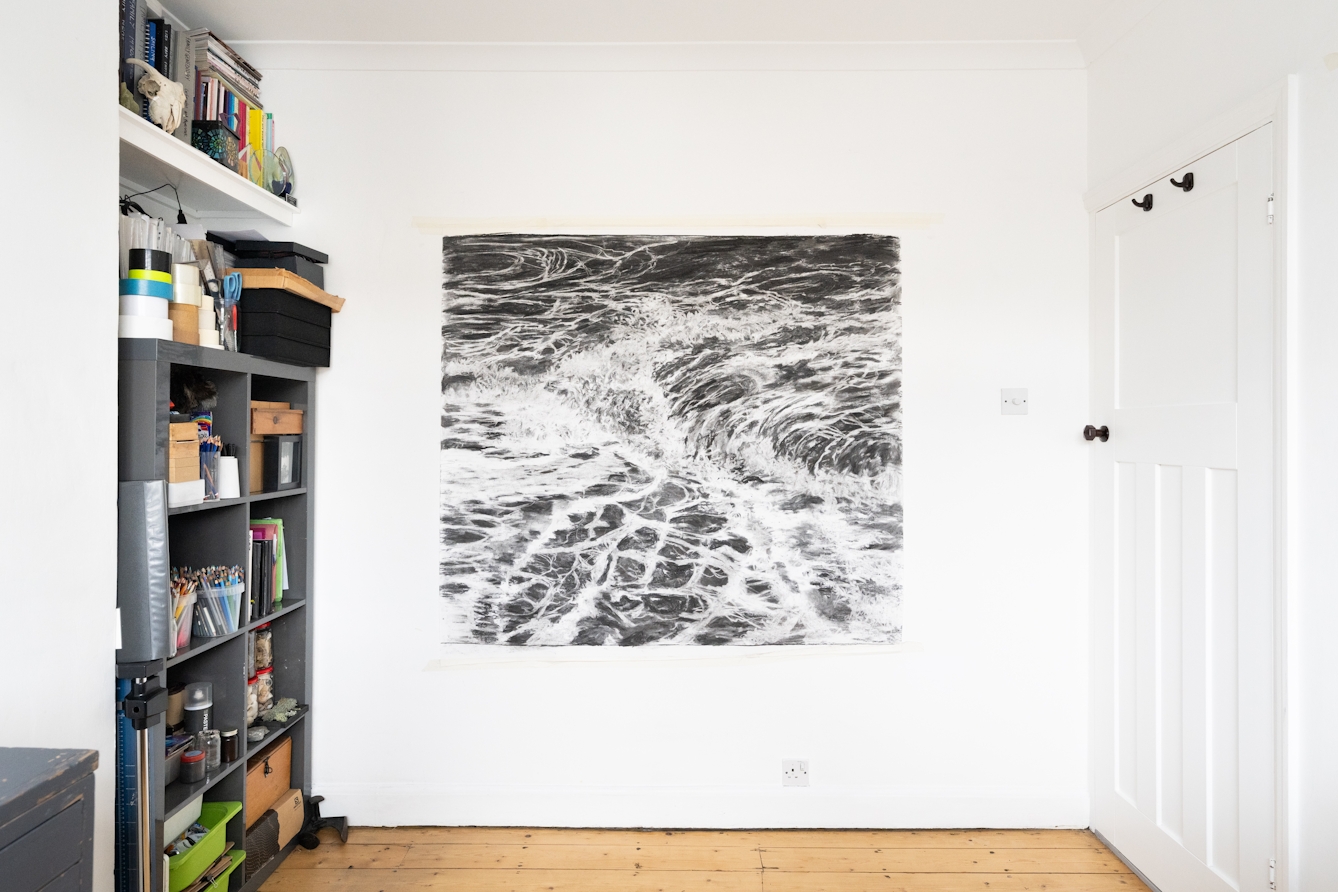
“I relocated to Whitstable on the Kent coast, where I have found a new affinity with the restlessness of the sea.”
My skin picking does wax and wane. I think of it now as a reliable gauge of my emotions and whether I need to attend to a dysregulated feeling. Irritability, anxiety, grief, anger, boredom – too much or too little stimulus brings on the picking.
Drawing remains a significant way for me to process complex and distressing experiences. I have started creating large-scale sea-foam drawings, turmoil and tense energy in my body capsizing into the mindful rhythms that flood out across the page.
Pinched fingers which used to pick at wounds or blemishes on my body hold charcoal instead. A mark is made on paper instead of skin as I navigate my way through.
About the contributors
Liz Atkin
Liz Atkin is an artist and educator. She reimagines her compulsive skin picking and anxiety into drawings, photographs and performances. Liz is a mental health advocate and raises awareness for the disorder around the world. She is an ambassador for the Big Draw, the world’s largest drawing festival, focusing on the role of creativity for health and wellbeing. Her work has featured on TEDx, BBC News, Woman’s Hour, Vice, Women’s Health USA, Huffington Post, Channel News Asia, Metro, Al Jazeera and more.
Steven Pocock
Steven is a photographer at Wellcome. His photography takes inspiration from the museum’s rich and varied collections. He enjoys collaborating on creative projects and taking them to imaginative places.
